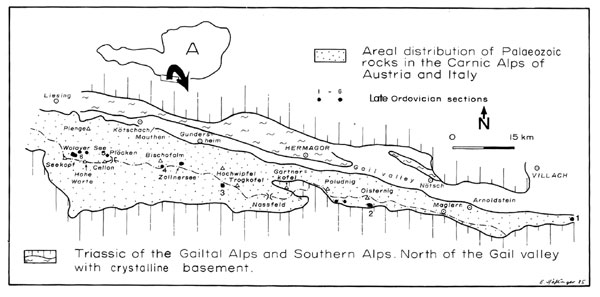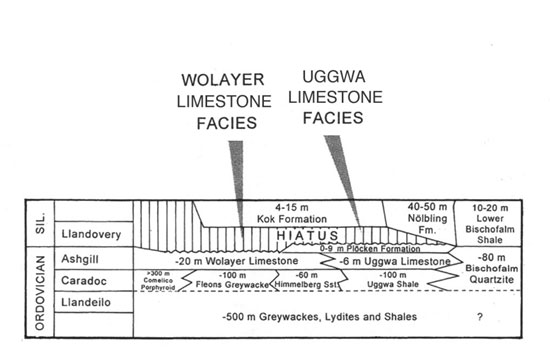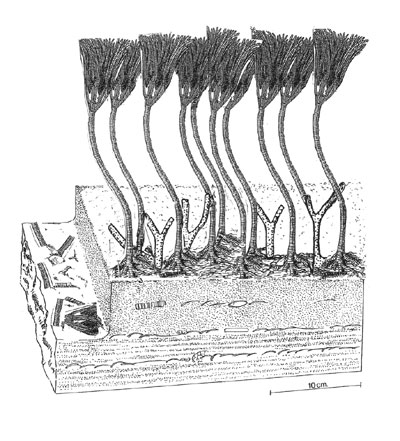
Ashgill crinozoan–bryozoan carbonates in the Carnic Alps: comparison with modern New Zealand shelf carbonates
William B.N. Berry1
1 Department of Earth and Planetary Science, University of California, Berkeley, CA 94720 USA. E–mail: bberry@uclink4.berkeley.edu
Key words: Carbonates. Shelf enviroments. Ashgill. Carnic Alps. New Zealand.
Introduction
In their discussion of the Ashgill Cystoid Limestone Formation in northeastern Spain, Vennin and others (1998, p. 121) pointed out that "shallow water carbonates of Ashgill age were deposited throughout northern Gondwana" just prior to glaciation. They suggested that these limestones were "of temperate origin." Nelson (1988) and Nelson and others (1988) described occurrences of carbonates accumulating today in temperate waters in a symposium volume dedicated to discussions of modern and ancient temperate water carbonates. The Wolayer carbonate facies in the Carnic Alps (Figure 1), an area that lay close to 50 degrees south latitude in the Late Ordovician (Schönlaub, 1992), bears certain similarities to both modern shelf carbonates and to the Spanish Cystoid Limestone described by Vennin and others (1998).
The Carnic Alps
Two carbonate facies, the Uggwa and Wolayer, are interbedded within the primarily siliclastic Upper Ordovician stratal sequence in the Carnic Alps (Figure 2). Schönlaub (1992), Dullo (1992), Kreutzer (1992), and Ferretti and Schönlaub, (2001) pointed out that the Wolayer carbonates accumulated in a relatively shallow shelf environment whereas the Uggwa facies accumulated as a series of debris flows on a slope and deep shelf. Carbonates in both of these facies have yielded Amorphognathoides ordovicicus conodonts (Ferretti and Schönlaub, 2001). Rawytheyian brachiopods were obtained by Hamman from the lower beds in the Uggwa limestones (Schönlaub, oral commun., 2001). Ashgill shelly faunas occur in the Wolayer limestones (Ferretti and Schönlaub, 2001). Persculptograptus persculptus and Hirnantian shelly faunas have been obtained from strata superjacent to the Uggwa limestones (Ferretti and Schönlaub, 2001; Berry, 2003).
The Wolayer limestones appear in the field to be primarily white, massive and composed of coarse–grained skeletal materials. Most of the skeletal materials are columnals of crinozoans. Calices of crinoids and cystoids occur in the Wolayer along with partly to fully fragmented bryozoan colonies. Study of the accumulation of grains composing the Wolayer indicates that certain areas within the Wolyer are small mounds of crinozoan and bryozoan skeletal fragments. Dullo (1962) studied thin sections of the Wolayer limestones and suggested that much of the Wolayer formed from patches of crinozoans and bryozoans that were communities of baffling organisms. These communities may have functioned as small reef–like structures. Erosion surfaces in the upper part of the Wolayer indicate that wave action swept crinozoan–bryozoan skeletal elements away to leave an erosion surface. Both Kreutzer (1992) and Dullo (1992) described and illustrated the prominence of crinozoan and bryozoan skeletal elements. Thin section analyses indicate that the Wolayer is composed almost entirely of medium to coarse–grained skeletal materials. Micrite and siliclastic materials are rare.

Figure 1. Map of Carnic Alps showing locations of Wolayer Limestone Facies (site 6). Site 6 is the approximate location of the Wolayer See. Localities 1 – 5 are outcrops of the Uggwa Limestone Facies.

Figure 2. Diagram indicating Upper Ordovician – Lower Silurian stratigraphy of the Carnic Alps (after Ferretti and Schonlaub, 2001).
Dullo (1992) examined the Wolayer carbonates not only in thin section but also with cathode luminescence. His (Dullo, 1992) study revealed vadose dog–tooth cements within the Wolayer. He suggested that erosion surfaces at the top of the Wolayer were created during sea level fall which took place as a consequence of Late Ordovician glaciation. Dullo’s (1992) study and the age of the Wolayer indicates that glacio–eustatic sea level fall exposed the shelf areas in which the crinozoans and other carbonte–secreting organisms lived and ended growth of these organisms.

Figure 3. Diagrammatic sketch of crinozoan–bryozoan thicket in the Wolayer Limestone.
Field observations of the Wolayer suggest that thickets of crinozoans and bryozoans developed on the shelf area during the latter part of the Ashgill, prior to the glacial episode. Crinozoans probably extended above the sea floor to a height greater than that of the bryozoans (Figure 3). Some brachiopods, trilobites, ostracodes as well as the conodont animals were attracted to these thickets. A few patches within the Wolayer appear to be sites of accumulations of crinozoan plates and calices held or trapped by upright bryozoans. In most other areas, crinozoan columnals and plates, bryozoan fragments and brachiopod and trilobite remains are scattered about as though the site had been winnowed by currents.
Modern New Zealand shelf carbonates
The Wolayer carbonate facies appears to bear certain similarities to the carbonates accumulating today at 47 to 49 degrees south latitude on the Snares Platform off the southern coast of the south island of New Zealand. Nelson and others (1988, p. 74) described these shelf carbonates, pointing out that little siliclastic material occurs in them and that "an important characteristic of these carbonates is their coarseness, more or less irrespective of water depth." These New Zealand shelf carbonates are composed of medium to coarse sand–sized grains that are primarily fragments of bryozoans and molluscan shells. Bryozoans with erect, relatively rigid, branching morphologies are the most common forms in the New Zealand shelf carbonates. Benthic foraminiferan shells comprise another significant component of the New Zealand shelf carbonates. Brachiopods also are present as well, but they a relatively minor component.
Nelson (l988, p. 3), in a discussion of the accumulation of "non–tropical" carbonates, stated that whereas "most geoscientists have traditionally regarded shallow–water carbonate formation as a low–latitude phenomenon", "wherever the rate and extent of terrigenous sediment dilution is small, the potential exists for extensive deposits of skeletal carbonate to accumulate on shelves beyond the (sub)tropics." Nelson (1988) reviewed occurrences of non–tropical carbonates noting that these carbonates are composed almost entirely of organismal skeletal fragments and that bryozoans are relatively common in all of them. The carbonate grains commonly are in the medium to coarse sand size. Ooids, peloids and carbonate aggregates are rare to absent. Non–tropical shelves lie poleward of the present limit of hermatypic coral reefs or beyond the mean annual surface water isotherm of about 20 degrees centigrade. Accumulation of siliclastic materials in modern temperate carbonates is very limited and modern temperate carbonate depositional environments commonly are swept by major storms. Nelson and others (l988) pointed out that enhanced water agitation resulting from these storms replenishes nutrients in the upper part of the oceans where they then become available to support a high level of plankton productivity. Nelson and others (1988, p. 81) suggested using the term bryomol to designate that "spectrum of bryozoan–bivalve skeletal carbonate deposits forming in temperate seas."
Conclusions
The Wolayer facies carbonates occur at approximately the same latitude as the modern New Zealand shelf carbonates. Both of these shelf carbonates are formed of medium to coarse sand–size grains that are derived from organisms, many of which are bryozoans. Siliclastics are rare in both. A difference between the Wolayer and the modern New Zealand carbonates is that at least some of the Wolayer carbonates developed from small crinozoan–bryozoan thickets that may have functioned as small patch reef–like structures that baffled and bound sediment. Crinozoans are prominent in the Wolayer carbonates whereas mollusks are prominent in the modern New Zealand shelf carbonates. Storm–generated water agitation leads to enhanced bryozoan and molluscan growth in the modern New Zealand carbonate shelf environments. Crinozoan and bryozoan growth in the Late Ordovician Carnic Alps shelf area may have been enhanced by similar activity. In addition to, or as a potential alternative to Late Ordovician storm activity stirring nutrients up into near–surface ocean waters, upwelling conditions created near the shelf margin during glacio–eustatic sea level fall could have led to enhanced nutrient availability in those waters. Significantly enhanced nutrient availability in near–surface ocean waters resulted in rich growth of organisms in shelf environments.
References
Berry, W.B.N. 2003. Late Ordovician environmental changes in Carnic Alps and central Nevada: a comparative study. Bull.Soc. geol. Fr., 174:
Dullo, W.–C. 1992. Mikrofazies und Diagenese der oberordovizischen Cystoideen–Kalke (Wolayerkalk) und ihre Schuttfazies (Uggwakalk) in den Karnischen Alpen. Geol. Bundesanst. Jahrb., 135: 317–333.
Ferretti, A. and Schönlaub, H.P. 2001. New conodont faunas from the Late Ordovician of the central Carnic Alps. Austria. Bol. Soc. Paleontol. Italiana., 40: 3–15.
Kreutzer, L.H.1992. Photoatlas zu den variszischen Karbonat–Gesteinen der Karnischen Alpen (Osterreich/Italien). Abhandl. Geol. Bundesanst., 47: 1–129.
Nelson, C.S. 1988. An introductory perspective on non–tropical shelf carbonates. Sed. Geol., 60: 3–12.
Nelson, C.S., Keane, S.L., and Head, P.S. 1988. Non–tropical carbonate deposits on the modern New Zealand shelf. Sed. Geol., 60: 71–94.
Schönlaub, H.P. 1992. Stratigraphy, biogeography and paleoclimatology of the Alpine Paleozoic and its implications for plate movements. Geol. Bundesanst .Jahrb., 135: 381–418.
Vennin, E., Alvaro, J.J., and Villas, E. 1998. High–latitude pelmatozoan–bryozoan mud–mounds from the late Ordovician northern Gondwana platform. Geol. Jour., 33: 121–140.
Received: February 15, 2003
Accepted: June 15, 2003